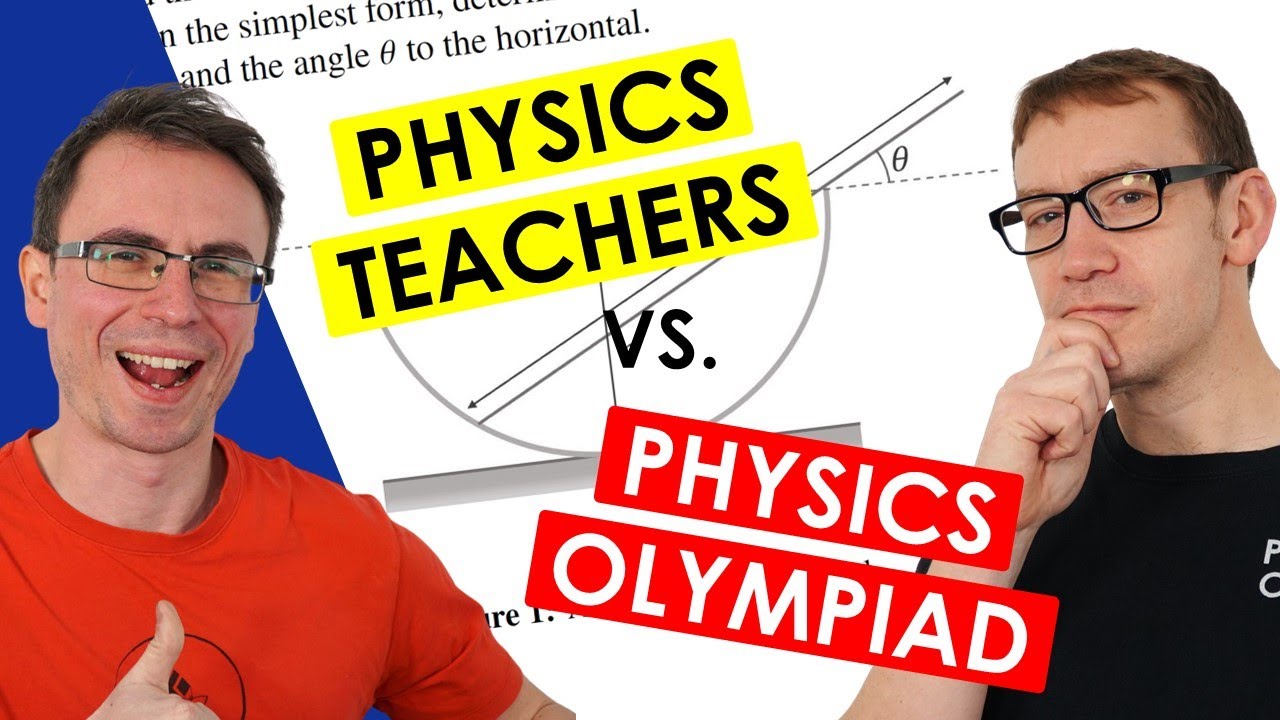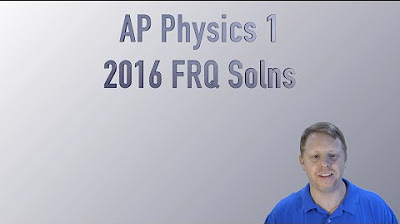My Solutions: British Physics Olympiad Round 1 2020 - Section 1 a to c
TLDRIn this video, the host walks viewers through solutions to physics problems from the 2020 British Physics Olympiad Round 1. The host emphasizes that these are not official solutions and encourages viewers to check the official mark scheme. The video covers estimating the height needed for a stone to reach a speed of 330 m/s in free fall, the physics behind a motorcycle's trajectory over a ramp, and the mechanics of two buckets on a pulley system. Detailed explanations, equations, and problem-solving techniques are provided throughout.
Takeaways
- 📚 The video focuses on solving problems from the 2020 British Physics Olympiad round one, with a disclaimer that these are not official solutions.
- 📝 Viewers are encouraged to refer to the official mark scheme and the British Physics Olympiad website for more resources and past papers.
- 🚀 The first problem involves estimating the height from which a heavy stone must be dropped to reach the Earth's surface at 330 meters per second using the SUVAT equations.
- 🏍️ The second problem involves calculating the time a motorcycle rider is airborne after leaving a ramp, using trigonometric and kinematic equations.
- 🕒 The rider's time of flight is derived using the horizontal component of motion, with considerations for trigonometry and distance traveled.
- 📐 The video also covers calculating the distance along the descending ramp by analyzing the vertical component of motion and factoring in gravitational acceleration.
- 🪣 In the third problem, two buckets hanging from a frictionless pulley are analyzed to determine the speed with which one bucket hits the ground, considering the forces acting on each bucket.
- 🎯 The acceleration of the system is found by solving a system of equations for the forces acting on the buckets.
- ⬆️ The video also addresses the additional height one bucket gains after the other bucket hits the ground, using SUVAT equations and energy considerations.
- 🔔 The video ends with a promise of more solutions from the same Olympiad set, encouraging viewers to like, subscribe, and stay tuned for future content.
Q & A
What is the primary focus of the video?
-The primary focus of the video is solving problems from the 2020 round one of the British Physics Olympiad.
What disclaimer does the speaker provide before starting the problem-solving session?
-The speaker provides a disclaimer that the solutions presented are not official and encourages viewers to check the official mark scheme available on the British Physics Olympiad website.
How does the speaker calculate the height from which a heavy stone needs to be dropped to reach a speed of 330 meters per second under free fall conditions?
-The speaker uses the SUVAT equation `v^2 = u^2 + 2as`, where the initial speed `u = 0`, final speed `v = 330` m/s, and acceleration `a = 9.81` m/s². By rearranging the equation, the height `s` is calculated as `5.56 × 10^3` meters, or approximately 5.6 kilometers.
In the motorcycle problem, what expression does the speaker derive for the time the rider is airborne?
-The speaker derives that the time the rider is airborne `T_a` is equal to the horizontal distance `L` divided by the initial speed `u`, or `T_a = L/u`.
How does the speaker determine the vertical motion of the rider in the motorcycle problem?
-The speaker uses the equation `s = ut + 1/2at^2` for vertical motion, accounting for the initial vertical speed and the gravitational acceleration. The tricky part noted is the need to consider the negative distance traveled as the rider falls, leading to the final expression for the vertical distance.
What is the final expression for the length `L` along the descending ramp in the motorcycle problem?
-The final expression derived for the length `L` is `L = 4u^2sinθ/g`, where `u` is the initial speed, `θ` is the angle of the ramp, and `g` is the gravitational acceleration.
How does the speaker approach the problem involving two buckets hanging from a rope over a frictionless pulley?
-The speaker analyzes the forces acting on each bucket, setting up equations for the tension and acceleration in the system. By solving these equations, the acceleration of the buckets is determined.
What is the derived expression for the acceleration of the buckets in the pulley problem?
-The acceleration `a` is derived as `a = g × (m_2 - m_1) / (m_1 + m_2)`, where `m_1` and `m_2` are the masses of the two buckets, and `g` is the gravitational acceleration.
How does the speaker calculate the further increase in height of bucket one after bucket two hits the ground?
-The speaker uses the SUVAT equation again to calculate the further increase in height `h_1`, taking into account the initial speed and the gravitational acceleration. The final expression derived is `h_1 = g × (m_2 - m_1) / (m_1 + m_2) × h`, where `h` is the initial height.
What additional content does the speaker promise to cover in future videos?
-The speaker promises to cover more problems from the 2020 British Physics Olympiad round one in future videos.
Outlines
📚 Introduction to British Physics Olympiad Problem Solving
In this video, the host introduces a session dedicated to solving problems from the 2020 round one of the British Physics Olympiad. They emphasize that the solutions provided are not official and encourage viewers to refer to the official mark scheme and the British Physics Olympiad website for resources like past papers and tips. The first question involves estimating the height from which a stone must be dropped to reach the Earth's surface at 330 meters per second in free fall conditions, using the kinematic equation v^2 = u^2 + 2as, where u = 0, v = 330, and a = 9.8, to find the height s as approximately 5.6 kilometers.
🔍 Analyzing a Motorcycle Ramp Problem
The second paragraph delves into a physics problem involving a motorcycle rider propelled up a symmetric ramp, reaching the apex and then performing a projectile motion before landing at a point P. The host explains the need to consider both the horizontal and vertical components of the rider's motion. Horizontally, the motion is at a constant velocity, and the host uses trigonometry to relate the horizontal distance x to the ramp's length l and the angle θ. The vertical motion is analyzed using the kinematic equation to account for the initial upward velocity and the acceleration due to gravity, leading to an expression for the time of flight t_a and the horizontal distance x in terms of l, u, and θ.
📐 Solving a Pulley System Problem with Two Buckets
In the third paragraph, the script discusses a problem involving two buckets hanging from a rope over a frictionless pulley. The heavier bucket on the right starts from a height h above the ground. The host explains the forces acting on each bucket and sets up a system of equations to find the acceleration a of the system. By considering the tension and gravitational forces, they derive an expression for a in terms of the masses m1 and m2, and the gravitational acceleration g. The final goal is to determine the speed at which the heavier bucket hits the ground.
🚀 Further Analysis of the Bucket System and Additional Height Calculation
The final paragraph continues the analysis of the bucket system, focusing on the additional height h1 that the first bucket ascends after the second bucket hits the ground and stops. The host uses the previously found speed of the second bucket at impact to calculate the initial speed of the first bucket. Applying the kinematic equation v^2 = u^2 + 2as again, they rearrange to find h1 in terms of g, m1, m2, and h. The summary concludes with the expression for h1, highlighting the interesting dynamics of the system after the second bucket's impact.
Mindmap
Keywords
💡Free Fall
💡Gravitational Acceleration
💡Projectile Motion
💡Trigonometry
💡Suvard Equations
💡Symmetry
💡Frictionless Pulley
💡Tension
💡Acceleration
💡Conservation of Energy
💡British Physics Olympiad
Highlights
Introduction to solving problems from the 2020 round one of the British Physics Olympiad.
Disclaimer about the unofficial nature of the solutions provided.
Recommendation to check the official mark scheme and British Physics Olympiad website for resources.
Question one involves estimating the height from which a stone must be dropped to reach 330 m/s in free fall.
Use of the kinematic equation v^2 = u^2 + 2as to solve for the height of the drop.
Calculation of the stone's falling distance, resulting in approximately 5.6 kilometers.
Question two discusses a motorcycle rider propelled up a symmetric ramp and airborne as a projectile.
Derivation of expressions for the time the rider is airborne using horizontal and vertical motion analysis.
Explanation of the horizontal motion with constant speed and its relation to the time of flight.
Vertical motion analysis involving the initial velocity, time of flight, and acceleration due to gravity.
Solving for the length of the descending ramp using trigonometric relationships and kinematic equations.
Question three involves two buckets on a rope over a pulley with different masses and the speed of bucket two hitting the ground.
Analysis of forces acting on each bucket and the resulting acceleration using Newton's laws.
Determination of the speed at which bucket two hits the ground using derived acceleration.
Further increase in height of bucket one after bucket two hits the ground and stops, a challenging problem.
Use of kinematic equations to find the additional height bucket one travels after bucket two's impact.
Upcoming video content cover more problems from the 2020 British Physics Olympiad round one.
Encouragement for viewers to like, subscribe, and look forward to the next video.
Transcripts
Browse More Related Video

Tips and overview of Round 1 of the British Physics Olympiad

2019 #2 Free Response Question - AP Physics 1 - Exam Solution

My Solutions to the British Physics Olympiad, BPhO Senior Challenge 2019 Multiple Choice

Here is a HARD Physics Olympiad Question - BPhO Round 1, Section 2 2020

A Level Physics Teachers Take On Olympiad Questions

AP Physics 1 2016 Free Response Solutions
5.0 / 5 (0 votes)
Thanks for rating: